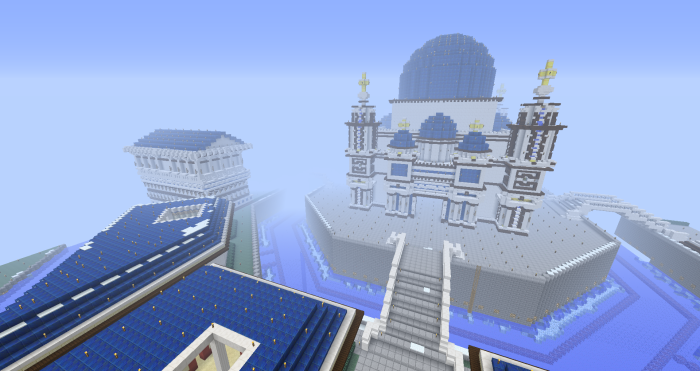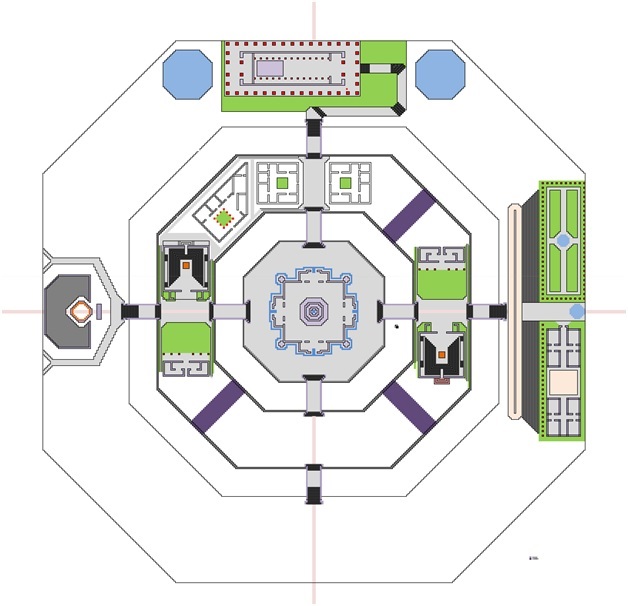The summer is coming and I am drinking in the sweet success of having finished my undergraduate. After four years of attending lecture after lecture, it was a refreshing change to attend ENGL 398E: Video Games and/as Theory in my last semester and do something a bit different. Our Professor Darren Wershler proposed a semester long project in Minecraft building whatever we would like on the unmodded TAG server. Naturally, telling a classroom full of video game fans that they can use playtime for credits was positively received, but this project was not without its integration of theoretical concepts.
For this project we were expected to be creative and try to test the limits of Minecraft and what it expected of its players. Ian Bogost’s chapter ‘Carpentry’ in his book Alien Phenomenology, or What It’s Like to Be a Thing was the key article assigned to us that addressed the concept of creating something as a practical application of philosophical concepts. By engaging in the real life logistical issues and problems that arise from interacting with real things, we learn more about our object of study than if we were to sit in a library and read about other people’s experiences.
So, our class had the exciting prospect of making something in Minecraft on the unmodded TAG server. But what? When you are given free rein to create whatever you want, what do you do? I joined up with ten other people and we called ourselves “Group X” and started brainstorming.

Our super awesome Facebook Group banner, created by Christian Leroux
Our team wracked our brains trying to come up with something big enough to impress and fun enough to work on for an entire semester, until I suggested Atlantis. The mythical city of Plato’s writings, referenced by countless other writers through the years, immediately captured the imagination of our group. My experience with the myth of Atlantis came mostly from my childhood playing a Sierra Entertainment game called EcoQuest: the Search for Cetus. Released in 1991, the game told the story of a boy named Adam who befriends a talking dolphin who asks him for his help in finding Cetus, a sperm whale who is king of the underwater city of Eluria. Along the way, the player must collect as much garbage as possible from the ocean floor to try and preserve the natural beauty of the ocean. The ancient Greek architecture makes Eluria a shoe-in for the city of Atlantis, and by framing their game around the damage humans were having on the ocean floor they created a fun and educational game that entertained me for hours when I was younger.
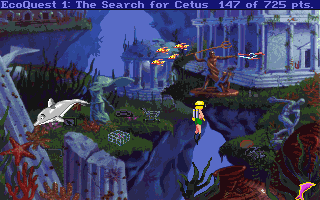
Screenshot of EcoQuest: The Search for Cetus. Garbage can be seen littering the landscape.
To try and create an entire underwater city would be impressive to say the least, and our group was stoked to try and recreating a city so many people have tried to find over the ages.
We began playing around with the Minecraft server and soon realized that we might have to make some changes to our original idea. We had only one real Minecraft expert on our team (I am forever indebted to you BigHairCutPrime!), and the logistics of creating an underwater city would be difficult for us amateurs to achieve in our timeframe. We began looking at what it was about Atlantis that had made us so enthralled with the idea. We soon realized that we were interested in the idea of a perfect city and a utopian civilization, where all people were considered equal and had equal access to public works. But in looking at Platos Dialogues “Critias” and “Timaeus”, we realized that Atlantis was originally described as a place which advocated slavery and tyranny. We decided to remodel our build as a thriving utopia instead of a broken underwater wreck and named it ‘Atlantis Transcends’. To reflect this idea we decided to build our Atlantis 150 blocks above the original landscape of the Minecraft server as a floating island, which fixed our problem with building underwater and gave us more freedom to create whatever we wanted.
BigHairCutPrime struck out into the wilderness first and made us a massive base far away from the other teammates to avoid griefing, while I researched the lore of the lost city and other members began becoming accustomed to the world of Minecraft. All of our build dimensions and buildings are based off of our interpretation of Plato’s description of the ancient city and what buildings would have most likely existed for the use of its population. The original dimensions Plato described were too massive for our timeframe, so we scaled down the area of Atlantis by roughly 75%, and even then the island had a circumference of 390 blocks.
We set up our build a short way away from our base, in a location where the natural landscape was full of pools and large oak trees. We then built up 150 blocks and began laying out the outline of our island. As soon as we started to lay out the foundation of our utopia we began to realize how much we had bitten off. Half of the semester was devoted to laying down block after block of dirt to create the rings of the island, and also engaging in the laborious task of digging up dirt at the main base and bringing it to the build site. The reason that we had to take the extra step and dig the dirt necessary for our build at our main base instead of at under our build site was because of the unforeseen complication of dealing with a survival server in Minecraft. Our island was so large that it blocked the sun from shining on the picturesque landscape below it, creating a breeding ground for monsters. If one of our team members would fall off the island, it was impossible to try and recover their tools and materials because of the many creepers, zombies and monsters waiting to attack.

Screenshot of the underside of our build and the eternal night.
At this point we had the beginnings of an impressive hunk of dirt in the sky and I started proudly showing off our area of the Minecraft server to other TAG members. When I was walking through the base to head to the build site Gina stopped me and pointed to the bare rock outside of our base.
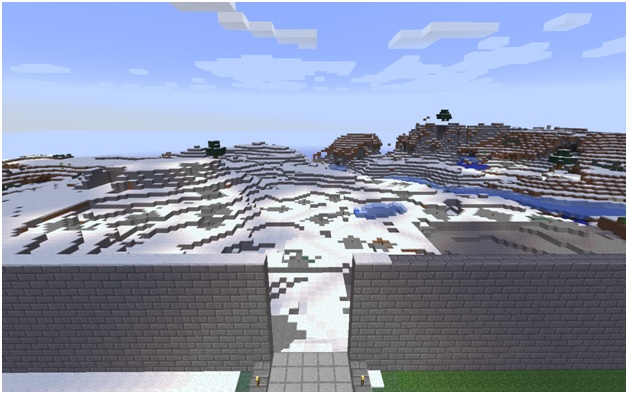
The view from our base of the landscape stripped bare of dirt
“Look at that, it’s like a wasteland.”
“But its progress!” I said, “Come look at what we have done with all of that dirt! Isn’t that what you want to see?” At this point I began to realize the ethical complications that arose from our build, and how Carpentry really came into play with what we had done. Here I was crowing over the fact that we had stripped away the natural beauty of the landscape to create an exclusive, artificial paradise far away. Just like in EcoQuest: The Search for Cetus, I came face to face with the environmental impact we as humans were having on our surroundings. It was so easy to fall into that trap of excitement over what we could do, versus what we ethically should do.
Thankfully, at this point BigHaircutPrime was developing a duplication machine that reduced our visual impact on the environment and saved us countless hours gathering rare materials.
Watch BigHairCutPrime’s Explanation of the Duplication Machine!
Even though we had our duplication machine working at full tilt to get us the resources necessary, by this time it was coming dangerously close to the deadline and blocks still needed to be placed by hand. We were also getting into the more intricate pieces of the building design, and many of us were occupied with projects for other classes or personal issues. What kept us slogging through the many hours of following blueprints and outlines was the community that formed in the server. Throughout the semester we would complain, joke, listen to music and support each other as we built our projects, and would then look forward to seeing each other next time we would log on. This sense of community was strongest for me when I attended the mass held at the Church of the Helix Fossil built by Group Chaos. It was right at the end of the semester and we were all stressed, but I had never felt so excited to go and see what they had been working on. Seeing over 15 people that I had talked to for months on the server congregating in one space all together was really great, and was an enjoyable break from the drudgery of construction.
Watch The Church of The Helix Fossil Service!
By the end of the semester, we were all exhausted. Since our build was so high up we had to deal with a lot of lag, and the frustrations mounted with the amount of work that needed to be done before the due date. We had complications concerning people dropping out of the class, and accusations flew about particular members not doing their fair share of the work. We had devolved from the initial excitement at the beginning of the semester to a grim acceptance of the work that would never be completed to achieve our original goal.
Eventually though we pulled ourselves through the difficult stress of the end of the semester and finished everything we set out to build. But what was more important than the physical artifact of ‘Atlantis Transcends’ was the process of spending those many hours on the server, engaging with other team members and observing our impact on the landscape. What was amazing to me at the end of this experience was the endurance of the relationships I made with the people I met and interacted with online, versus the ones where we were lumped into a group in the classroom. Being online and talking to my teammates and other group members behind the guise of a game made us more open and frank with each other, and I met people I would have never interacted with in the classroom because of its rigid structure of a lecture hall. Even with the frustration and stress of the last few weeks of the project the bonds formed through online communication on the server stayed strong and we learnt much more than we ever would have writing an essay the night before it was due.
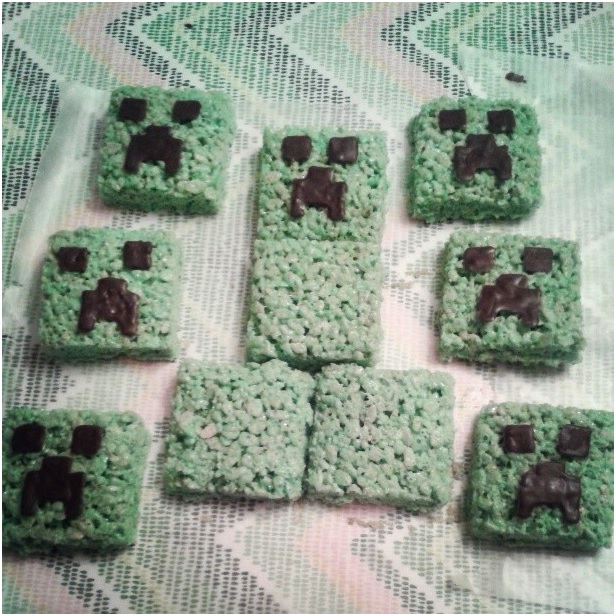
Creeper Rice Krispie Squares made for our class after party by Megan Sachin.
To see more about our Minecraft build ‘Atlantis Transcends’, check out our WordPress website!
http://mcprojectatlantis.wordpress.com/

